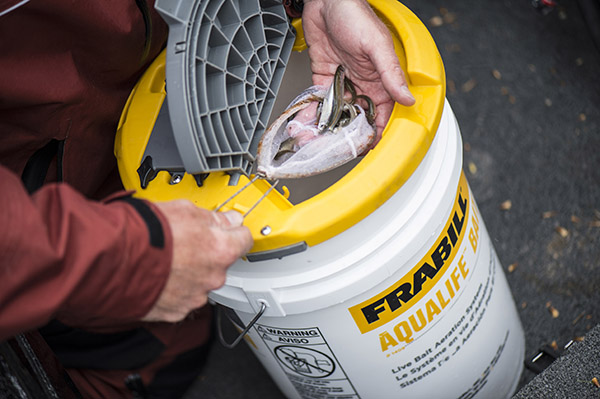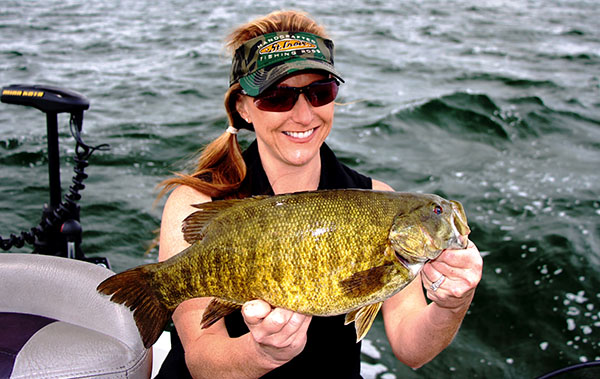Time-tested fall fishing pattern

Head to your nearest river, because Mother Nature’s clock is ticking and smallmouth are smacking
Dr. Jason Halfen
ur experiences as anglers are coupled to the rhythms of Mother Nature. When the lilacs bloom in spring, expect to find crappies and bluegills in the shallows. Forty-five days after the ice goes out, walleyes will have made their way to the weed edges that separate shallow flats from deep basins. When the drone of summer cicadas fills the evening air, topwater froggin’ for largemouth will be in full swing.
And as the maple leaves turn from green to shades of yellow and crimson, it’s time to slip your boat into your favorite river for an autumn smallmouth bonanza.

Shorter days and cooling water temperatures trigger predictable movements of both prey and predator. Baitfish that have spent the warmer months in slow runs and shallow pools, hiding among abundant summer weed growth, now have fewer places to hide as that greenery withers and dies. As autumn progresses, finned-forage concentrate in deeper holes, typically found in the outside bends of smaller rivers, or in the scour holes found below dams or off the tips of wingdams in larger rivers. Our primary targets, walleyes and smallmouth bass, follow this bait movement in lockstep. As the water cools and their general metabolic level decreases, these larger predators have less energy to spend fighting the current in swift, shallow stretches, a trend that further concentrates them in deeper pools, holes, and related areas that feature moderate flow.
So, as river waters cool through the 50s and into the 40s, smallies and walleyes concentrate in easy-to-locate areas. While there, they feed actively to build up the reserves needed to survive winter, and to develop their reproductive tissues that will get exercised next spring. This annual confluence of circumstances gives anglers a window of opportunity to enjoy some of the best, and most consistent fishing of the year. Here are two simple techniques that will put river bronze and gold in your boat this fall.
Fall smallies love-love bait!
River smallmouth cover long distances in search of suitable wintering habitat. A deep hole along a sweeping bend in a relatively shallow river, or at a confluence of two smaller rivers, can become a season-long home to an uncountable number of river smallies. As long as water temperatures don’t dip into the 30s, these fish will eat, and eat often. Recognize that many of the ways that we chased bronze during the warmer months aren’t nearly as effective in the fall: fish are slowing down and conserving energy, working to maximize food intake while minimizing calorie burn. Offer them something hearty, dangle it helplessly in front of their face, and most smallmouth will be unable to resist.
Enter the time-tested, ever-vulnerable, sucker minnow.
nd a 4” sucker minnow, or similarly sized chub, beneath a tapered balsa float, drift that rig through a deep hole teeming with smallmouth, and you’re in for a real treat. Once the fall smallmouth migration kicks into full swing, generally as water temperatures dip into the 50s, this presentation can frequently be the right recipe both size and numbers. While the basic method is clearly related to the bobber-fishing you’ve enjoyed since your youth, a few refinements will bring more fall smallies to hand this year.
Proper bait-maintenance is imperative for two reasons. Firstly, unless you’re trapping bait, upsized minnows are flat-out expensive. One or two floaters in the bucket is pretty normal. Losing a dozen or more can be attributed to mismanagement, like not getting the bait on oxygen immediately, or banging them around in a hoarder’s ice cream pail. Secondly, the bait’s onstage performance will either bomb at the box office or garner critical praise in the form of strikes. Lively, freely swimming minnows will produce smallmouth bass. Corpse bait is better suited for catfish.
I rely on Frabill’s healthcare plan, specifically the 1469 AquaLife™ Bait Station. At a whopping 6-gallons, and with its sophisticated, oxygen enrichening micro-bubbler diffuser, the Bait Station can easily appease a couple dozen of the beefiest minnows.
Onto the hook... Circle hooks are an excellent choice for live-baiting smallmouths. Used properly, circle hooks lead to fish being pinned in the corner of the mouth, with very (very!) few fish hooked deep. Please leave the trebles and J-shaped hooks at home.
Tie the hook with fluorocarbon line, preferably with Seaguar AbrazX, because of its enhanced abrasion resistance. Given that we’re fishing in a river, full of rocks, fallen timber, and sharp objects ranging from zebra mussels to old refrigerators, we need all the abrasion-resistance we can get; Seaguar’s AbrazX delivers, and complements its resiliency with fluorocarbons’ strength, sensitivity, and near invisibility under water.
Rather than use a braided main line with an AbrazX leader, I spool up completely with 12-pound test AbrazX and run it right down to the bait. Fall air temperatures can frequently dip below freezing, and I don’t want a frozen braid dampening my fun. The chemical nature of fluorocarbon also renders it very water repellent.
Dangle your minnow beneath a tapered balsa float. Unlike walleye, which tend to be bottom-oriented, fall smallmouth will frequently suspend; as long as your bait ends up within a foot or two of the bottom, you should be in business. Any higher, and you’re likely to encounter another schooling, suspending river fish: channel cats. But that’s a tale for another day.
A long rod that provides good casting distance, moves a lot of line on the hookset, and delivers the leverage needed to conquer a rampaging brown bass is the next piece in the fall smallmouth equation. If you’re fishing from a boat, a rod like the Drift-N-Float Rod in the St. Croix Legend Tournament Walleye series (LTWS80MLF2) fits the bill. This eight-foot rod provides the length needed to lob a bobber-and-sucker combo long distances, while its medium-light power and fast action provide the right combination of rod attributes to deliver positive hooksets while still enjoying the fight.
Fall is here. Now is the time to enjoy some of the best, and most consistent, fishing of the year. Get that boat in the water, because Mother Nature’s clock is ticking, and winter’s snow and ice will be here soon enough. What are you waiting for?
About the author
Dr. Jason Halfen owns and operates The Technological Angler, dedicated to teaching anglers to leverage modern technology to find and catch more fish. Let your learning begin at http://www.technologicalangler.com.











